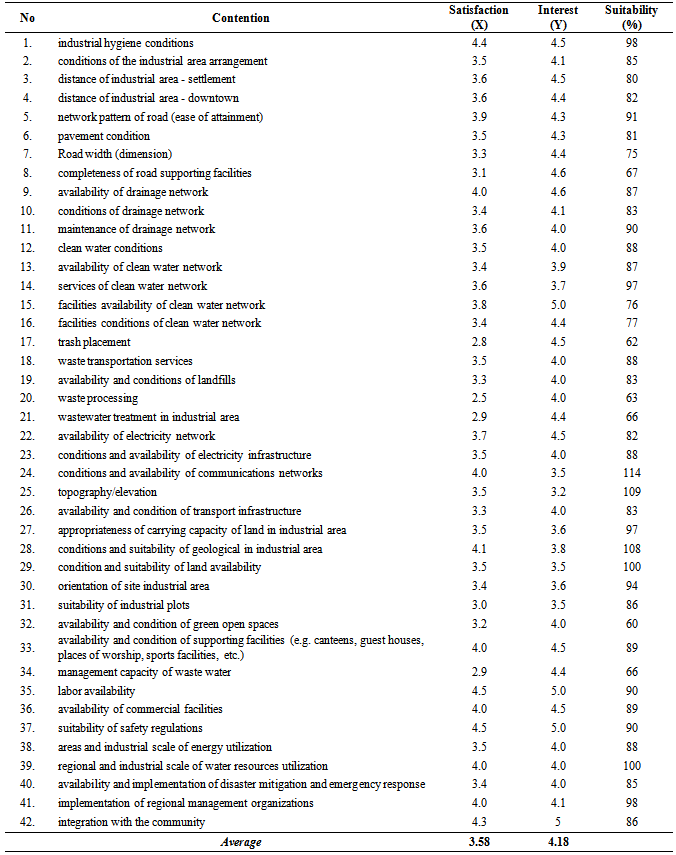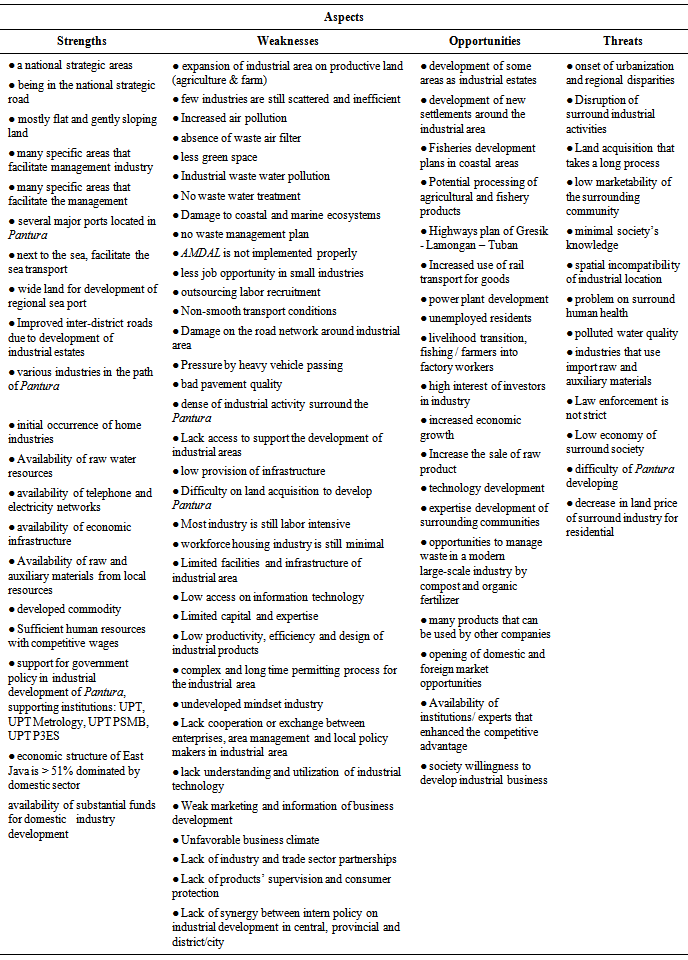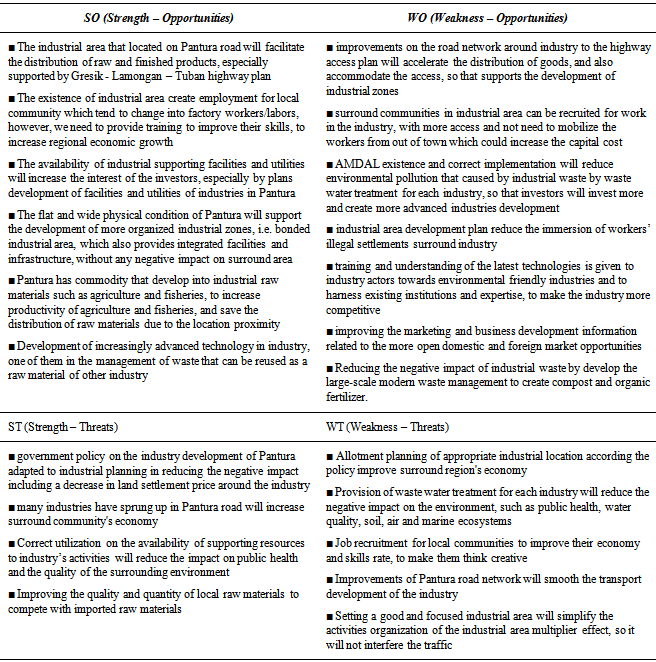-
Paper Information
- Next Paper
- Previous Paper
- Paper Submission
-
Journal Information
- About This Journal
- Editorial Board
- Current Issue
- Archive
- Author Guidelines
- Contact Us
American Journal of Sociological Research
p-ISSN: 2166-5443 e-ISSN: 2166-5451
2014; 4(2): 42-52
doi:10.5923/j.sociology.20140402.04
Strategy Development of Western East Java Industrial Area
Budi Santosa1, 2, Surjono1, 3, Arief Rachmansyah1, 4, Soemarno1, 5
1Environmental Science and Technology Graduate Program, University of Brawijaya, Indonesia
2Provincial Development Planning Agency of East Java Province, Indonesia
3Department of Urban-Regional Planning Engineering, Faculty of Engineering, University of Brawijaya, Indonesia
4Department of Civil Engineering, Faculty of Engineering, University of Brawijaya, Indonesia
5Department of Soil, Faculty of Agriculture, University of Brawijaya, Indonesia
Correspondence to: Budi Santosa, Environmental Science and Technology Graduate Program, University of Brawijaya, Indonesia.
| Email: |  |
Copyright © 2014 Scientific & Academic Publishing. All Rights Reserved.
The aim of this research is to make recommendations on the strategy development of Eco-Industrial Park in the western north coast (Pantura) of East Java, so that existing industrial area can improve according to the concept of the environmentally and sustainable industrial area. We also explain the strengths and weaknesses of the industrial western north coast area and identify the macro environment (external) factor which may affect the current and future development of the industrial park management in western Pantura. This study uses IPA, SWOT and IFAS EFAS analysis. The results concluded as Selective Maintenance Strategy using moderate scenario, i.e. make improvements to some non-optimal crucial aspect. The development of the industrial area should be done gradually and focused more on the crucial aspects that have the most support and ready to be developed.
Keywords: Important Performance Analysis, SWOT, EFAS, IFAS, Selective Maintenance Strategy
Cite this paper: Budi Santosa, Surjono, Arief Rachmansyah, Soemarno, Strategy Development of Western East Java Industrial Area, American Journal of Sociological Research, Vol. 4 No. 2, 2014, pp. 42-52. doi: 10.5923/j.sociology.20140402.04.
Article Outline
1. Introduction
- Eco-Industrial Parks (EIPs) is a concept that distributed in many countries as a model of a new industry that provide sustainable dimension – managing industry practices and activities to achieve sustainable development goals. It is mutually beneficial for society, economy and environment which are clearly stated in the definition of EIPs concept [1, 2, 3].EIP is viewed as the application of industrial ecology in practice. EIP can be defined as a community of manufacturing and businesses service in the environmental and economic performance through collaboration in managing environmental and resource issues. In cooperation, business community looking for a collective benefit that is greater than individual benefits, so that each company will realize unoptimal individual performance [4, 5, 6].EIP is defined as manufacturing and service businesses community that located together on a common property. Business members are looking for economic performance, social and environmental enhanced through collaboration in managing environmental issues and resources. By working together, the business community’s collective profit is greater than individual benefits. The goal of an EIP is to improve the economic performance of the participating companies while minimizing their environmental impact. Components of this approach include green design infrastructure and parks, net production, pollution prevention, energy efficiency and the partnership between the companies. EIP is also beneficial for the local community to ensure positive net impact of development [7, 8, 9].As the development of the industrial area in the western part of the northern coast (Pantura) of East Java cause various problems, e.g. environmental degradation, the claims and conflicts between the industry and the public about the industry related to the welfare gap, environmental pollution potential of liquid, gas/air, solid as a result of industrial activities and technical issues related to the limitations of the raw water resource, the source of energy generation and industrial waste management controls that affect the sustainability of the industry.In this era of globalization and free market, the industry faced with stiff competition, so that comparative advantage is a past mainstay cannot overcome the free market challenges. Increased efficiency is a key to improve competitiveness against similar products from neighboring countries and other countries to Indonesia and also in export products. Only competitive advantage and a qualified product will be able to thrive and win the competition in a free market [10].Industrial activity is needed to boost economic growth, but on the other hand, the activity can also be a cause of environmental damage and negatively impact on the surrounding community. Since global environmental issues and the concept of sustainable development emerged, the industry is also expected to contribute to the achievement of a harmonious relationship between activity and mutual support in the industry with the surrounding ecosystem. Thus, the birth of environmental friendly concept in industrial estate is one of the industry's responses to global environmental change.Construction and development of Indonesian industrial estates are generally regulated by government policy through Presidential Decree that followed by Regulation of Industry Ministry and Decree of the Department Head of National Land. Conceptual development of industrial estates in Indonesia is an integrated development process that considers many related aspects. The most important development is the location aspects (selecting the right site that meets specified criteria). This aspect will determine the success of the ideal development, which is encourage an increase in people's income and still protecting the environment.Western North coast of East Java is a strategic region and has the highest economic growth compared to other regions in Indonesia, not least within the area of East Java. The strategic value makes this area should be developed in a focused, organized and well planned strategic role that maintained regard to environmental aspects. The area has a huge potential to accommodate the development of activities to support regional development and utilization of natural resources, especially the activities of emerging industries in East Java. These conditions implied from the increasing number of land-use change in the northern coastal region which is directed to support industrial activities and opportunities for local government districts to grow industrial activities in regional development policies. The support for the local government policy is to boost the economy of the region concerned as a consequence of the policy of regional autonomy.The purpose of this study is to formulate appropriate strategies to construct an industrial estate towards the development of Eco-Industrial Park, where industry players in an industrial area can jointly improve performance of environment, economy and social by minimizing environmental impacts and also has the ability to produce competitive products advantage in the market.
2. Materials and Methods
- This study used a qualitative approach. The method of data collection is field observation and structured interviews. Analysis method used Importance Performance Analysis (IPA), Strength, Weakness, Opportunity, Threats (SWOT), Internal and External Factors Analysis Summary EFAS IFAS.
2.1. Study Area
- Research on EIPs or environmentally sound industry is located in the North Coast region (Pantura), East Java. The selection of location was based on consideration of the increasing number of even one of the orientation coast into a new industrial site in East Java. Selected Pantura location includes Gresik, Lamongan and Tuban (Fig. 1).
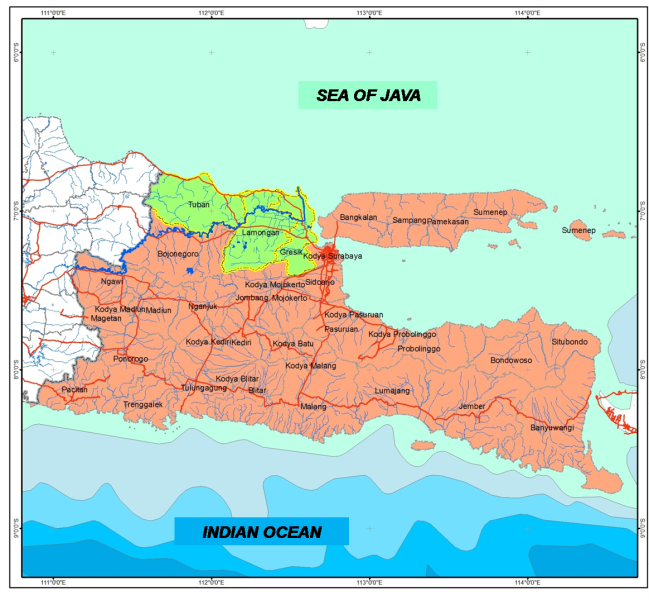 | Figure 1. Orientation of Gresik, Lamongan and Tuban on East Java [11] |
2.2. Data Collection
- Conducted surveys are field observations and structured interviews. Field survey was conducted in four months (January-April 2013). Respondents of this research are community in an industrial area of north coast and the government as policy maker. Society as a respondent was drawn randomly in three study sites.Steps in this primary survey are to identify the strengths and weaknesses with input from of the previous analysis, both characteristics and factor analysis. This identification is supported by the analysis of potential problems, detect macro environment (external) which may affect the development of current and future industrial park management in western Pantura of East Java. The last step is to formulate strategies that might be implemented with reflect or a combination of strength indicator (S), weaknesses (W), opportunities (O), and threats (T) which has been found in the previous two steps.
2.3. Data Analysis
2.3.1. Importance Performance Analysis (IPA)
- Assessment on the level of satisfaction or perception to the condition of the industrial area in western Pantura, East Java analyzed with a combination of importance level attributes and perceptions on the quality of the industrial area existence into a two-dimensional form. Parties who provide the assessment are industry and surrounding communities. To facilitate the discussion on the level of satisfaction and interest in the condition of the industrial area in Pantura, the IPA analysis performed on industrial zones along the Western Pantura East Java lane [12]. The results of the analysis covers four different suggestions based on the size of the interest rate and the quality of services, which then used to establish the strategy on planning, development and management of industrial estates in the north coast region.The scale used in this study is five levels with a weight rating of the expected rate of interest and perception assessment on the condition of the industrial park is very satisfied/important as rate 5 and if very dissatisfied/ unimportant is 1.
2.3.1. SWOT and EFAS IFAS
- We analyzed the determining management strategies of western Pantura industrial area by SWOT, EFAS and IFAS analysis. SWOT analysis is an analysis to determine the factors that influence the management of the industry, i.e. Strengths, Weaknesses, Opportunities and Threats. We also inventoried these factors in planning strategy that is used as the basis to determine the corrective measures required in subsequent development [13]. Determination of the development basic concepts based on SWOT analysis by assessing (weighted) using the IFAS - EFAS analysis. The results of assessment are displayed in the form of quadrants that will determine the future development strategy. We assess every aspect of SWOT to weighted from 0,00 to 1,00 – the aspects of each factors (internal/external) are summed to produce a weight of 1. After weighting criteria, rating is given to indicate the level of importance (1=somewhat important, 2 = important, 3 = very important). The weighting value multiplied by the specified rating. The sum of each factor (internal/external) then totaled to know the location of the SWOT quadrant in determining the development strategy.
3. Results and Discussion
- Questionnaires to industry players obtained following table 1.
|
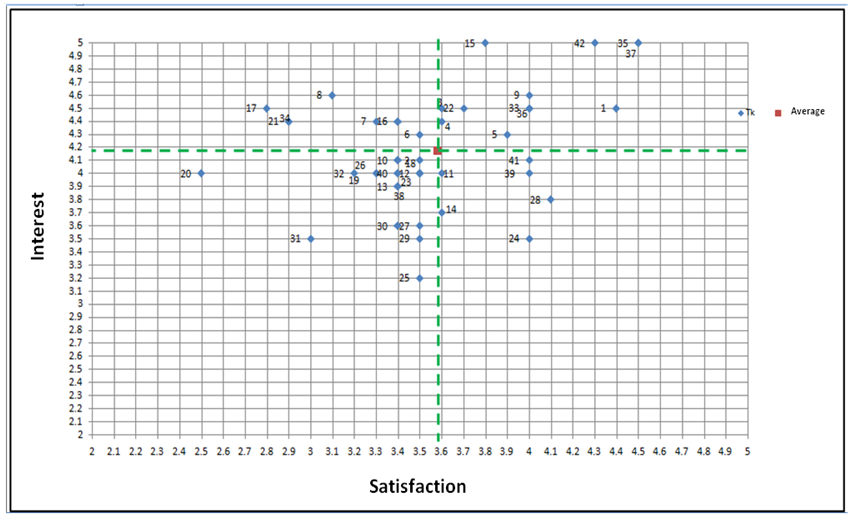 | Figure 2. IPA Cartesian Diagram of Industry Actors |
|
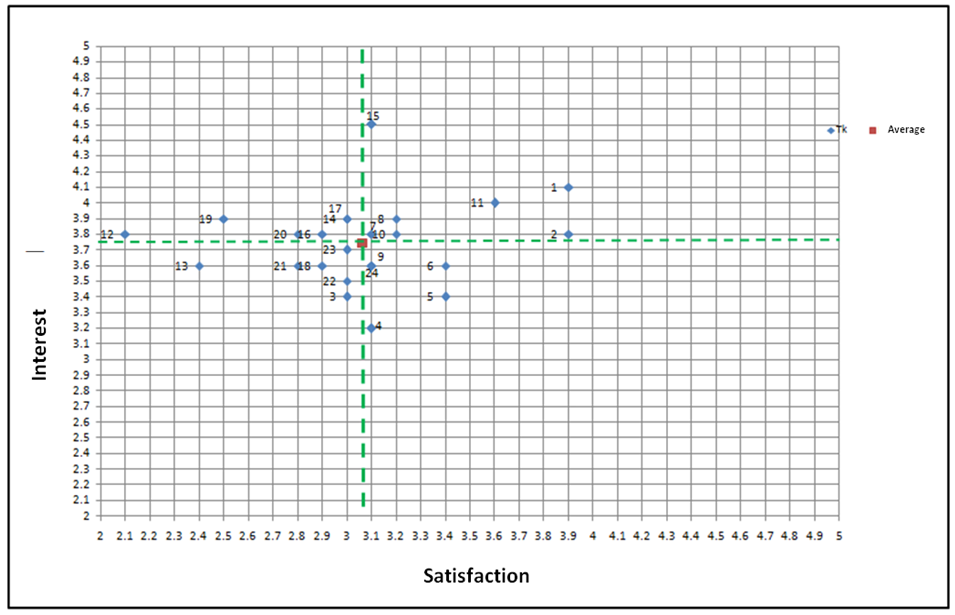 | Figure 3. Cartesian Diagram of Public’ IPA |
|
|
 = 0.85 + (-1.435)
= 0.85 + (-1.435) = - 0.585Y= OPPORTUNITIES + THREATS
= - 0.585Y= OPPORTUNITIES + THREATS = 1.41 + (-0.965)
= 1.41 + (-0.965) = 0.445Farther, we can scheme the SWOT analysis on the development strategy of Western Pantura in Fig. 4. The role of industrial sector in economic development is essential for the growth of the industrial sector to create jobs and accommodate workforces that increase the income and purchasing ability. The increase in income and purchasing ability indicate that the economy is growing and healthy. Industrial activities also produce the goods and services that needed by the community, generating foreign exchange through exports and conserve foreign exchange by import substitution products. Rapid industrial growth stimulates the development of other sectors, e.g. financial institutions, marketing, trading, advertising and transportation. All services sector will support industrial growth rate that lead to widespread employment opportunities, which in turn increases the income and purchasing ability of local communities. Besides providing a positive impact on the national economy, industrial activity also had negative impacts on environment, e.g. pollution of soil, water and air. The more rapid growth of an industry in a country, it will adversely affect the sustainability of the environment if improperly managed. It is due to the environmental problems that arise from the interaction between human activity and natural resources, or more precisely is the mechanism of supply and demand on environment or the environment offers. Unbalanced interaction and harmony between these two aspects can cause environmental problems. The high demand for environmental resources that is not supported by the availability and supply of environmental resources will lead to excessive exploitation of the environment that could eventually lead to environmental degradation [19,20,21].
= 0.445Farther, we can scheme the SWOT analysis on the development strategy of Western Pantura in Fig. 4. The role of industrial sector in economic development is essential for the growth of the industrial sector to create jobs and accommodate workforces that increase the income and purchasing ability. The increase in income and purchasing ability indicate that the economy is growing and healthy. Industrial activities also produce the goods and services that needed by the community, generating foreign exchange through exports and conserve foreign exchange by import substitution products. Rapid industrial growth stimulates the development of other sectors, e.g. financial institutions, marketing, trading, advertising and transportation. All services sector will support industrial growth rate that lead to widespread employment opportunities, which in turn increases the income and purchasing ability of local communities. Besides providing a positive impact on the national economy, industrial activity also had negative impacts on environment, e.g. pollution of soil, water and air. The more rapid growth of an industry in a country, it will adversely affect the sustainability of the environment if improperly managed. It is due to the environmental problems that arise from the interaction between human activity and natural resources, or more precisely is the mechanism of supply and demand on environment or the environment offers. Unbalanced interaction and harmony between these two aspects can cause environmental problems. The high demand for environmental resources that is not supported by the availability and supply of environmental resources will lead to excessive exploitation of the environment that could eventually lead to environmental degradation [19,20,21].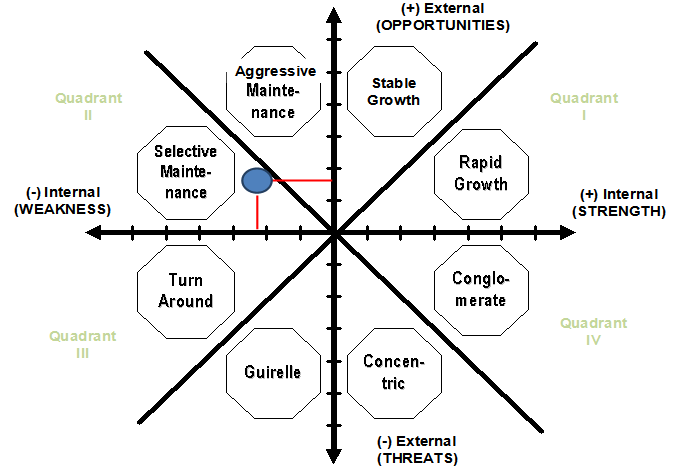 | Figure 4. Quadrant of IFAs - EFAS Analysis Strategy on Industrial Area Development of Pantura |
|
4. Good Corporate Governance
- If the concept of Eco - Industrial Park was successfully applied in western Pantura Industrial Area, the Government must hold the basic principles on elaboration of assessment and stages for manifesting Good Corporate Governance. Standard benchmarks in evaluating the success of the application of Good Corporate Governance are:a. Transparency; the company ensure transparency in the decision making process and in expressing material and relevant information about the company.b. Autonomy; which guarantees a professional company management with no conflict of interest and influence/ pressure from any unrelated party with the legislation and the principles of healthy corporate.c. Accountability; company ensure clarity of function, implementation and responsibility to create effective corporate management.d. Responsibility; company ensure conformity management that in line with the laws, regulations and the principles of healthy corporate.e. Fairness; the company ensure justice and equality in occupy stakeholder rights that arising under laws and regulation.The corporation will be managed properly if the commitment shared between the owner/stakeholder, commissioner and Directors Board is interpreted as consent or promise which involved parties emotionally compelled liability. The expected commitments are to be healthy and ethical management. Created rules and practices are consistently leads to the achievement of objectives. Structured corporation must have written rules to realize the commitment on Corporate Governance (Code of Corporate Governance), which oriented to improving the value of Shareholders and Stakeholders. Any financial requirement on improvement and development of the Eco - Industrial Park on western Pantura Industrial Area should include local government and the private sector. The local governments are East Java Province, Gresik, Lamongan and Tuban, whereas the private sectors are investors in the industry of Western Pantura, East Java.
5. Conclusions
- Management strategy of industrial development in Western Pantura, East Java is using Selective Maintenance Strategy where area management of industrial development is selecting the aspects that considered as crucial. Referring to the IPA analysis, several crucial aspects need for further development/improvement because it has high interest factor yet the performance is unoptimal, e.g. pavement condition, road dimensions, completeness of road supporting facilities, waste treatment in the industry area, the capacity of the waste water treatment management, conditions of clean water facilities, garbage placement, availability and condition of open green spaces, air pollution in industrial areas, the company's efforts to prevent development conflicts between local communities, response and follow-up on society’s comments and complaints, social legitimacy on exploitation of natural resources in the local area, the companies contribution towards social corporate, and related party agreements regarding the welfare of local residents.The selected scenario in the Industrial Area development of Western Pantura, East Java is the second scenario (moderate) because it is the most realistic choice since there are some problems, such as unoptimal supporting facilities, unprepared institutional systems and so forth. So the development of the industrial area of Western Pantura, East Java will be done gradually though not fully optimized yet. The improvement is focused more on the crucial aspects that have the most support and ready to be developed.
ACKNOWLEDGEMENTS
- The author would like to thank the Governor of East Java, the Government of Gresik, the Government of Lamongan, Government of Tuban, Rector and Director of Graduate Program of Brawijaya University, entrepreneurs and communities in Gresik, Lamongan and Tuban Industrial Area.
 Abstract
Abstract Reference
Reference Full-Text PDF
Full-Text PDF Full-text HTML
Full-text HTML